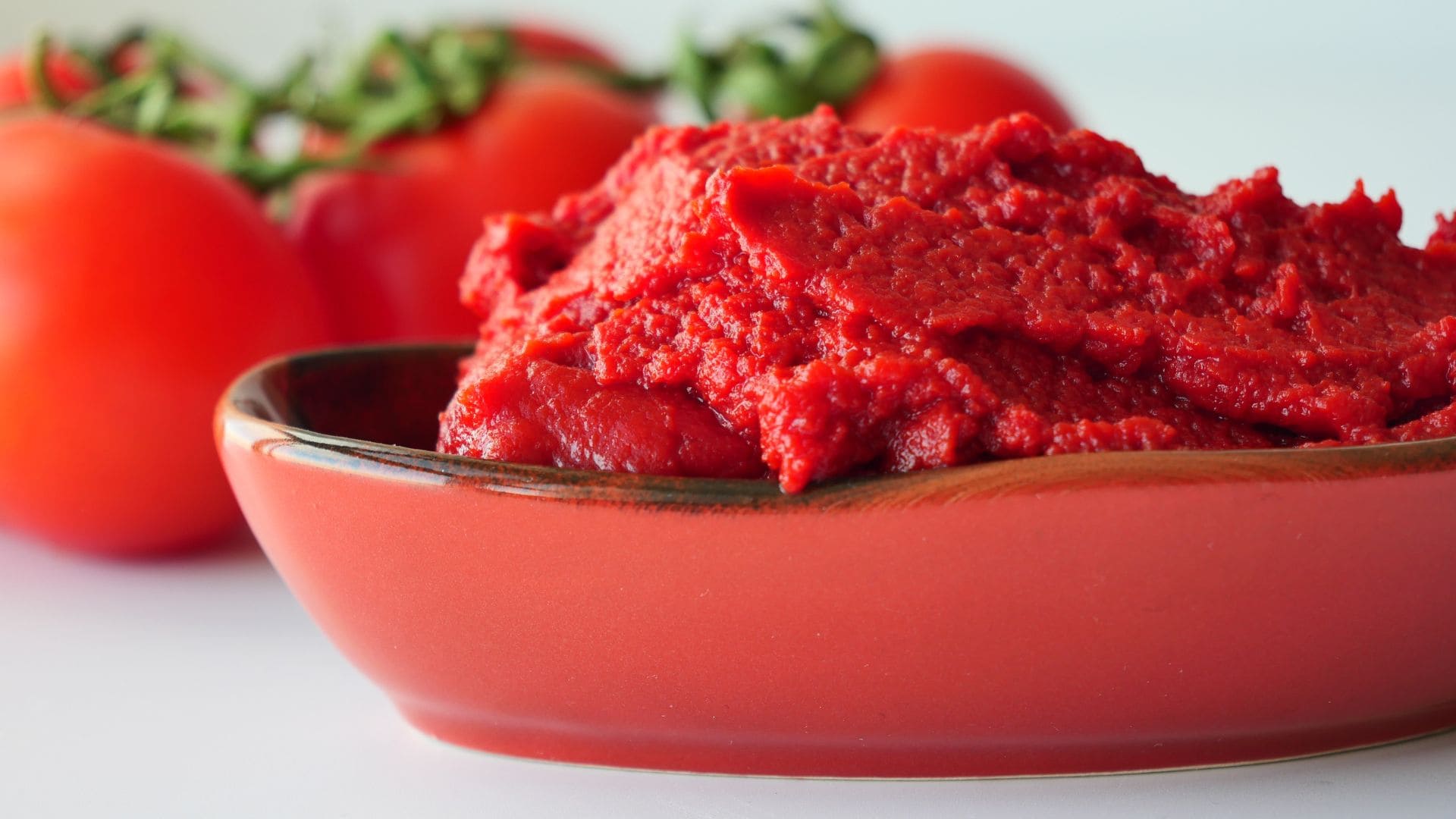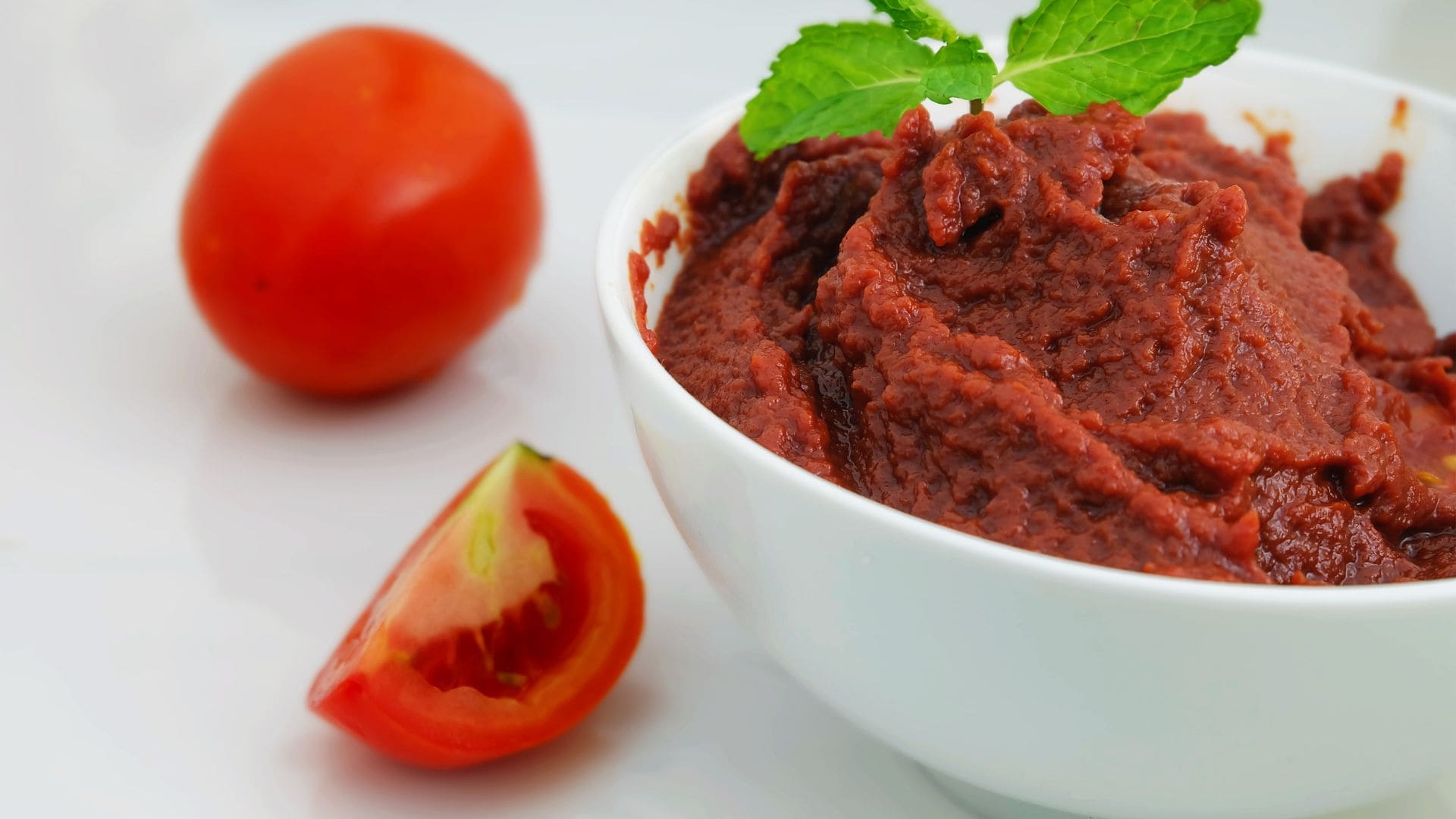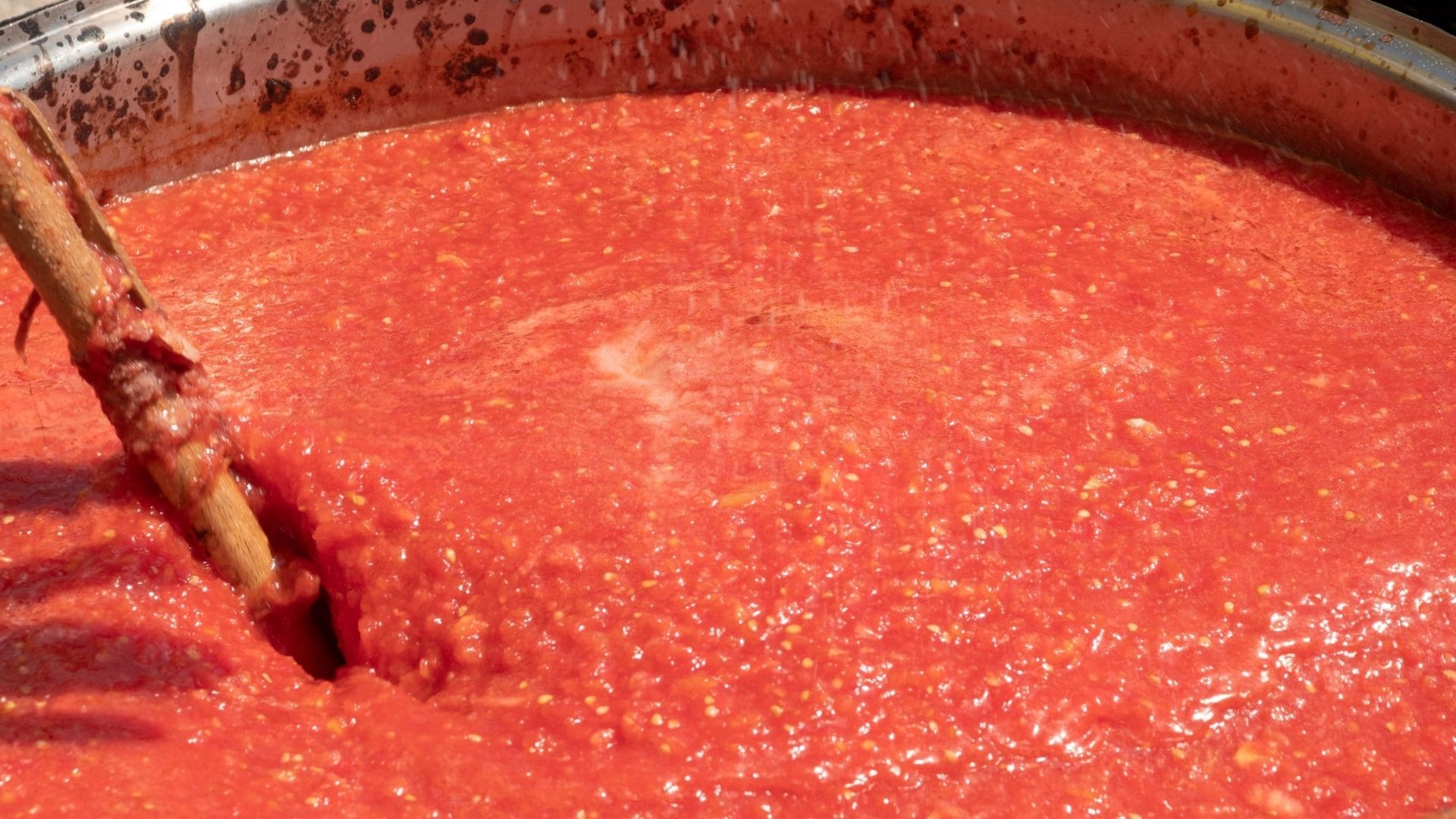Tomato paste, known as salça in Turkish, is a staple ingredient in many kitchens around the world, especially in Turkish, Middle Eastern, and Mediterranean cuisine. Whether you’re enhancing a stew, adding depth to a pasta sauce, or simply infusing your dishes with rich tomato flavor, tomato paste is an essential component. At Mama Fatma, with our locations in Mississauga, we understand the importance of using high-quality, homemade ingredients to create authentic dishes. In this blog post, we’ll delve into the art of making tomato paste, from selecting the perfect tomatoes to mastering the traditional techniques passed down through generations.
Blog Contents
ToggleSelecting the Right Tomatoes for Paste
The quality of your tomato paste starts with the tomatoes you choose. Not all tomatoes are created equal, and selecting the right variety is crucial for achieving that rich, concentrated flavor.
1. Roma Tomatoes: The Go-To Choice
When it comes to making tomato paste, Roma tomatoes are the gold standard. Their dense flesh, lower water content, and fewer seeds make them ideal for creating a thick, flavorful paste. If you’re wondering how to make tomato paste that’s rich and smooth, start with a bushel of ripe Roma tomatoes.
2. Heirloom Tomatoes for a Unique Flavor
While Roma tomatoes are the traditional choice, heirloom varieties can add a unique depth of flavor to your tomato paste. These tomatoes come in various shapes, colors, and flavors, which can give your paste a slightly different taste and color. However, keep in mind that heirloom tomatoes typically have more water content, so they require longer cooking times to achieve the desired consistency.
3. Organic vs. Conventional Tomatoes
For the freshest, most vibrant flavor, organic tomatoes are often preferred. They are grown without synthetic pesticides and fertilizers, which can affect the taste. If you’re sourcing your tomatoes from a local farmer’s market or directly from a garden, organic options might be the best choice for your homemade salça.

Traditional vs. Modern Methods of Making Paste
Making tomato paste at home is a labor of love, and the method you choose can significantly impact the flavor and texture of the final product. While modern conveniences have made the process easier, many still swear by traditional methods.
1. Traditional Sun-Drying Method
In Turkey, one of the most traditional methods for making salça involves sun-drying. Tomatoes are peeled, deseeded, and then spread out on large trays under the sun, where they slowly dehydrate over several days. This method intensifies the tomato’s flavor and gives the paste a deep, rich color. However, it requires consistent sunny weather and a good deal of space, making it less practical for those living in cooler climates or urban areas like Toronto, Ontario, Canada.
2. Modern Stovetop Method
For those who want to enjoy homemade tomato paste without waiting days for it to dry in the sun, the stovetop method is a convenient alternative. Tomatoes are cooked down slowly over several hours, allowing the water to evaporate and the flavors to concentrate. This method is much faster and can be done in any kitchen, regardless of the weather.
3. Using an Oven for Controlled Drying
Another modern method involves using an oven set to a low temperature to dry out the tomatoes. This combines the benefits of sun-drying with the control and convenience of the stovetop method. The tomatoes are cooked until they reach the desired consistency, which can then be blended and stored.
Key Ingredients and Equipment Needed
Making tomato paste at home requires a few key ingredients and tools, but nothing too complex. Here’s what you’ll need to get started.
1. Fresh Tomatoes
As discussed, the type of tomatoes you choose is crucial. You’ll need about 10 pounds of tomatoes to make approximately 2 cups of tomato paste.
2. Salt
Salt not only enhances the flavor but also acts as a preservative, helping your tomato paste last longer. Use kosher salt or sea salt for the best results.
3. Olive Oil
A small amount of olive oil can be added to the paste for flavor and to help preserve it. This is particularly useful if you’re planning to store your paste for a longer period.
4. Equipment: A Must-Have List
- Large Pot: Essential for cooking down the tomatoes.
- Food Mill or Blender: A food mill helps remove the skins and seeds, resulting in a smoother paste. A blender can be used if you prefer a more rustic texture.
- Baking Trays or Oven-Safe Dishes: These are used if you’re drying the tomatoes in the oven or sun.
- Storage Jars or Containers: Glass jars with airtight lids are ideal for storing the finished tomato paste.
How to Achieve the Perfect Consistency
The consistency of your tomato paste is one of the most important factors in its quality. Whether you’re aiming for a thick, spreadable paste or something a bit looser, here’s how to get it just right.
1. Reducing Moisture: The Key to Thickness
The primary goal when making tomato paste is to reduce the moisture content. This is done by cooking the tomatoes down until they reach a thick, concentrated consistency. For the stovetop method, this means simmering the tomatoes on low heat for several hours, stirring occasionally to prevent burning.
2. Using a Food Mill for Smoothness
If you’re after a smooth, refined texture, a food mill is your best friend. It helps remove the skins and seeds, leaving behind only the pure tomato pulp. This step is especially important if you’re using tomatoes with thicker skins or more seeds.
3. Adjusting Consistency with Oil
If your tomato paste turns out a bit too thick, you can add a small amount of olive oil to loosen it up. This also adds a rich, silky texture to the paste. On the other hand, if the paste is too thin, continue cooking it down until it thickens to your liking.
Storage Tips for Homemade Tomato Paste
Once you’ve made your tomato paste, proper storage is crucial to maintaining its flavor and preventing spoilage. Here are some tips to keep your homemade salça fresh for as long as possible.
1. Refrigeration
If you plan to use your tomato paste within a few weeks, store it in the fridge. Transfer the paste into small glass jars or airtight containers, and pour a thin layer of olive oil on top to prevent oxidation. This method helps preserve the paste’s vibrant color and rich flavor.
2. Freezing for Long-Term Storage
For longer storage, freezing is the best option. Spoon the tomato paste into an ice cube tray and freeze until solid. Once frozen, transfer the cubes to a ziplock bag or airtight container. This way, you can easily use small portions of tomato paste without thawing the entire batch.
3. Vacuum Sealing
If you have a vacuum sealer, consider using it for storing larger quantities of tomato paste. Vacuum sealing removes the air from the package, which helps prevent freezer burn and extends the shelf life of your paste.
The Culture of Making Tomato Paste (Salça) at Home in Turkey
Making tomato paste at home is more than just a culinary activity; it’s a cultural tradition deeply rooted in Turkish households. The process of making salça is often a communal event, bringing together family and neighbors to share the labor and the fruits of their efforts.
1. A Time-Honored Tradition
In many parts of Turkey, especially in rural areas, making tomato paste is an annual ritual. Families gather large quantities of tomatoes at the peak of the harvest season, often sourcing them directly from local farmers. The process is a labor-intensive but rewarding task that involves peeling, deseeding, and cooking the tomatoes in large outdoor cauldrons.
2. Sharing the Harvest
Once the tomato paste is made, it’s often shared among family members and neighbors. This tradition of sharing is a reflection of the communal nature of Turkish culture, where food is not just sustenance but a means of bringing people together.
3. A Taste of Home
For many Turkish people living abroad, making tomato paste at home is a way to stay connected to their roots. The rich aroma of simmering tomatoes can evoke memories of childhood and home, making the effort of making salça well worth it.
The art of making tomato paste, or salça, is a beautiful blend of tradition, technique, and culture. Whether you’re using traditional sun-drying methods or modern stovetop techniques, the result is a rich, flavorful paste that can elevate any dish. At Mama Fatma, we understand the importance of quality ingredients and the role they play in creating authentic, delicious meals. If you’re ever in Mississauga, be sure to visit us and taste the difference that comes from using the best, homemade ingredients.
And remember, whether you’re following a traditional recipe or experimenting with your own techniques, making tomato paste at home is a rewarding experience that connects you to a long-standing culinary tradition. Happy cooking!

Eating Turkish Food the Healthy Way: A Guide to Mediterranean Wellness
When you think of healthy eating, your mind often jumps to salads or steamed fish. But Turkish cuisine, at its core, is one of the world’s original wellness diets. Rooted

The History Behind Your Favorite Turkish Dishes
Every bite of turkish dishes is a journey through time. From the smoky spices of Anatolia to the refined elegance of the Ottoman palaces, the food tells a story of

How Turkish Food Brings Families Together
In the heart of Turkish culture, food is far more than sustenance; it is the strongest glue holding families and communities together. The tradition of the sofra (the communal dining

How to Plan a Turkish Dinner Night at Home
There’s nothing quite as impressive and inviting as hosting a dinner party centered around Turkish cuisine. It’s a culture built on generosity, abundance, and the art of shared eating—a tradition

How to Enjoy Turkish Food Without Alcohol: The Art of Authentic Pairing
For many diners in the vibrant city of Toronto, the question of what to drink often defaults to wine or beer. But when sitting down to a truly authentic Turkish

Why Turkish Food Works for Every Season
Living in Toronto, Ontario, means experiencing the full spectrum of Canadian weather—from scorching summer humidity to the deep chill of winter. This drastic seasonal shift requires a flexible diet, and




